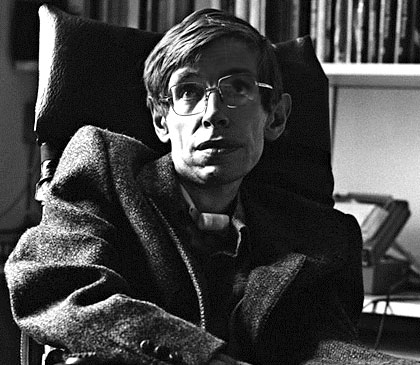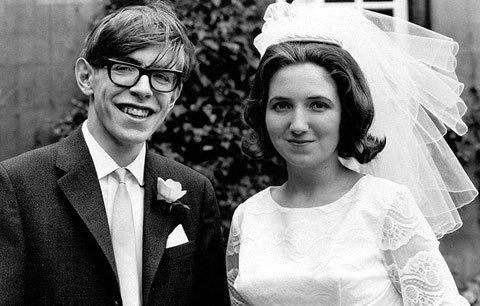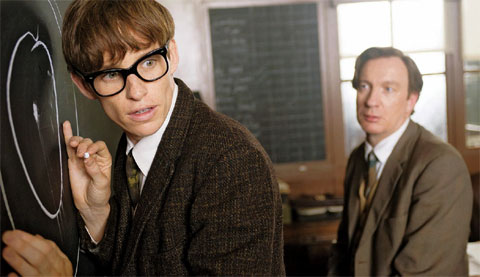Stephen Hawking, brief biography (Version in English/version en ingles).
(Stephen William Hawking, Oxford, 1942 - Cambridge, 2018) British theoretical physicist. Despite his physical disabilities and the progressive limitations imposed by the degenerative disease he suffered, Stephen Hawking is probably the best known physicist among the public since Einstein's time. Wrestler and winner, throughout his life he managed to overcome the immensity of impediments posed by the evil of Lou Gehrig, an amyotrophic lateral sclerosis that afflicted him since he was twenty years old. Hawking was, without a doubt, a particular case of vitality and resistance against the misfortune of destiny.

Stephen Hawking
Biography.
On January 8, 1942, the day on which three hundred years after the death of Galileo, Stephen Hawking was born in the city of Oxford. Like many others of middle class, his family supported with integrity the rigors of the Second World War; Towards the end of the race, a German V2 rocket fell a few dozen meters from his home in Highgate, north of London. After high school, Hawking entered the University College of Oxford, where he graduated in 1962 with the titles of mathematician and physicist. At that time he was a normal life boy, whose singularities were only his brilliant intelligence and a great interest in science.
But in 1963, in the course of an ice skating session, the young Stephen slipped and had difficulty getting up. He was immediately diagnosed with a degenerative neuromuscular disorder, ALS or amyotrophic lateral sclerosis. The doctors assumed that the disease was going to end his life in a few years; however, they were wrong. Naturally, Stephen's life was not the same thereafter, but his physical limitations did not interrupt his intellectual activity at any time; in fact, they increased it.
In October 1962 he had begun his PhD studies at Trinity Hall in Cambridge. He requested to work with Fred Hoyle, but the famous astronomer had too many suitors and the request was denied; many years later, Hawking himself would see the positive side: had he been accepted, he would probably have been forced to defend Hoyle's stationary state theory, discredited after the discovery of microwave background radiation in 1965.

With Jane Wayline the day of the wedding (1965)
While studying for his doctorate, he married Jane Wayline (1965), with whom he would have three children. After almost twenty-five years of life together, in 1990 the couple separated and the scientist went to live with Elaine Mason, one of the nurses who looked after him and with whom five years later he got married; this second relationship would continue until 2007. After obtaining the title of doctor in theoretical physics (1966), his passion for the study of the origin of the universe was increasing, and his research focused on the field of general relativity, particularly in the physics of black holes, first described by Robert Oppenheimer in 1939.
Certainly, Hawking is not only comparable with Albert Einstein for his popularity: like the formulator of the theory of relativity, Stephen Hawking set out the ambitious goal of harmonizing general relativity and quantum mechanics, in search of a unification of the physical that would account for both the universe and subatomic phenomena. In 1971 he suggested the formation, after the big bang, of numerous objects called "black holes", which would contain about a billion metric tons of mass, but would occupy only the space of a proton, a circumstance that would originate enormous gravitational fields, ruled by the laws of relativity.
His studies on black holes would lead him to combine for the first time the theory of relativity and quantum mechanics to solve the problem of studying these structures of very small dimensions and extraordinarily high density, which was not believed to be obtainable some knowledge In 1974 he proposed, according to the predictions of quantum physics, that black holes emit thermal radiation until their energy is exhausted and extinguished. Hawking has also explored some singularities of the space-time binomial.

Still from The Theory of Everything (2014), a film based on Hawking's life
In 1974 Hawking was appointed member of the Royal Society and, three years later, professor of gravitational physics in Cambridge, where he was awarded the Lucasiana chair of mathematics (1980), which had been dictated by such egregious figures as Isaac Newton and, more recently, Paul Dirac. Hawking would continue to hold this chair until his retirement in 2009. But as the intellectual achievements and recognitions were happening in his life (he has received countless awards and honorary doctorates), he also advanced the degenerative process of his illness. First the immobility of his limbs led him to depend on a wheelchair; then the paralysis spread to almost his entire body; in 1985 he contracted a pneumonia that forced doctors to perform a tracheotomy, after which he completely lost his speech. From then on he could only communicate through a synthesizer connected to his chair, but even that did not demoralize him: he wrote seven other books and continued to publish articles and give lectures.
A great popularizer.
It is a great paradox, no doubt, that a man who was fully involved in the task of clarifying scientific concepts for the average public (unlike most of his colleagues, Hawking decided decidedly by disclosure) would have to face hard with the difficulty of being able to communicate them. However, thanks to his persistence and tenacity, he did not stop saving the pitfalls that were derived from his physical disabilities. In 1989, on the occasion of his visit to Spain to receive the Prince of Asturias Award, Stephen Hawking stressed the importance of ordinary citizens possessing sufficient scientific notions to participate in the debates that open new scientific and technological advances, avoiding that everything is in the hands of the experts.
That is the message that is discovered in some of his most famous books, such as Historia del tiempo: from the big bang to the black holes (1988), which has been translated into thirty-seven languages and from which in a few years they were sold more than twenty million copies. In his intention to get the book to a broad audience, Stephen Hawking renounces the formulas and exhibitions for specialists, but does not abandon the rigorous treatment of the issue. It proceeds first to a broad presentation of current cosmological ideas (the big bang and the expansion of the universe), as well as the main findings of particle physics, which explain at a subatomic level what matter and the forces that govern it are . Hawking highlights the surprising convergence of these two research paths, which have given birth to a new discipline: the astrophysics of particles.
In History of Time the author also tackles, always keeping the tone of high disclosure, issues such as black holes and, in addition to the origin, the possible destiny of the universe. Nor does it elude the question that the common man formulates when faced with these questions: the role of God in all these phenomena, as well as the creation of the universe, at which point Stephen Hawking abandons the rigorously scientific treatment to venture into the uncertain paths of metaphysical speculation.
Other later books, like Black Holes and Small Universes (1994), The Universe in a Nutshell (2002) or The Great Design (2010), manifest an even greater informative intention than their previous books. Regarding its more specialized bibliography, its efforts to describe from a theoretical point of view the properties of black holes, as well as the relationship that these properties have with the laws of classical thermodynamics and quantum mechanics, have been collected in works as The Large Scale Structure of Space-Time (1973, in collaboration with GFR Ellis), Superspace and Supergravity (1981) and The Very Early Universe (1983).
Conclusion and reflection with my own words:
Stephen Hawking was a famous physicist who with his works, theories and essays, helped us to know the Universe, as we see it today, as for example, it is the case of black holes that emit their own radiation. Despite having a very severe disability condition that limited him physically, that never stopped him from continuing to discover the secrets that the Universe has, which leads us to the following reflection: if they have or know someone who has any disability condition, should know the following: do not give up, go ahead to achieve your dreams and goals that are proposed in this life, do not be afraid, do not look at the disability they have and trust their own abilities and they will see that they are capable of realizing your goals and dreams, you are the owners of your present and future and will be able to forge what you wish to achieve. Believe in yourselves and maybe one day you will be as famous and successful as Stephen Hawking was.
Rest in peace and fly very high Stephen Hawking, we will always remember you as someone great and as that person who overcame all the obstacles and difficulties that life imposed on you as a strong test of fire to show that you can get very far.
I hope you liked it a lot and do not forget to follow me, until the next friends.
Bibliographic references:
https://www.biografiasyvidas.com/biografia/h/hawking.htm